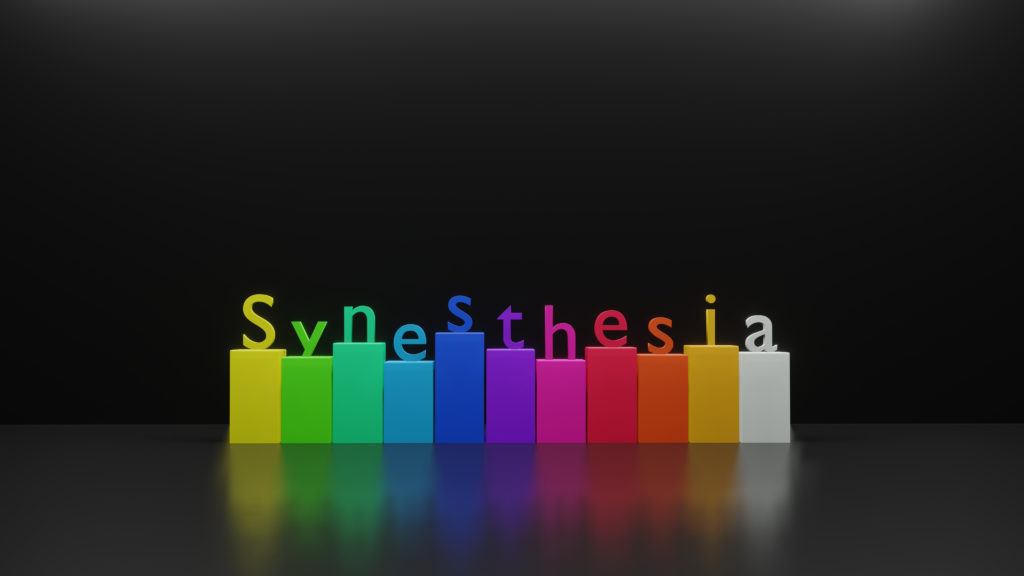
Psychology Today defines synesthesia as “a neurological condition in which stimulation of one sensory or cognitive pathway (for example, hearing) leads to automatic, involuntary experiences in a second sensory or cognitive pathway (such as vision).”1 Or, more simply, “when one sense is activated, another unrelated sense is activated at the same time.”
Basically, when people experience synesthesia, they can hear colors, smell sounds, and even taste music. And, to add to the complexity, almost every combination of sensory information is possible with synesthesia.1 Here a few of its most common manifestations.
- Grapheme-Color Synesthesia – Letters and numbers appear with specific colors.
- Auditory-Tactile Synesthesia – Hearing a sound causes a bodily sensation.
- Chromesthesia – Certain sounds cause a person to see colors.
- Lexical-Gustatory Synesthesia – Hearing certain words triggers specific tastes.
- Mirror-Touch Synesthesia – A person feels (tactile) what another is experiencing.
Interestingly, synesthesia can happen with or without taking drugs.
Some People Are Born That Way
Those who have experienced synesthesia from birth (called developmental or genuine synesthesia) are called synesthetes.1 People can also acquire synesthesia from the loss of a sense (e.g., blindness, deafness).2 The third type of synesthesia is drug-induced (pharmacological). Although researchers have observed some distinct differences between these types,3 the phenomenon has the common manifestations as described above. In his 2013 review paper, Dr. Jamie Ward gives some specific examples of the interplay between the senses.2
For example, the word ‘Phillip’ may taste of sour oranges, the letter A may be luminous red, and a C# note on the violin may be a brown fuzzy line extending from left to right in the lower left part of space.
The rate of occurrence of genuine synesthesia is approximately 1 in every 2000 people.4 In his 2002 book Synesthesia: A Union of the Senses, Dr. Richard Cytowic summarized what medicine understands about people who are born synesthetes.5
- It runs in their families. Genetically, it is passed on as a X-linked dominant trait.
- Women predominantly experience synesthesia at a ratio of 3:1 over men.
- Synesthetes have excellent memories.
- Synesthetes can have uneven cognitive skills (e.g., highly intelligent but bad at math).
- About 15% of synesthetes have a first-degree family history of dyslexia, autism, or attention deficit disorder.
Scientists don’t know the exact causes of developmental synesthesia.6 However, Ward’s review paper offers a thorough summary covering structural and functional differences in the brain and the possible role of genetics and the environment.2
The synesthetic perceptions elicited by psychedelics can be different from those of the developmental or acquired form, which adds to the intrigue of this phenomenon.
The Synesthesia Experience with Psychedelics
Drugs eliciting the synesthesia phenomenon include LSD,7 psilocybin,8 MDMA,9 and cannabis.10 LSD and psilocybin, in particular, can bring on synesthesia even at low doses.11,12 And, not all psychedelics give the same synesthetic effects. But that’s another article.
In their 2012 review paper in Consciousness and Cognition, Sinke et al. reported many more differences than similarities between the three types of synesthesia.3 Specifically, what is unique to the pharmacologically-induced (and acquired, though not discussed here) type merits further discussion.
Speaking to the consistency of the three synesthetic experiences, Sinke et al. summarize by saying,
Genuine synesthesia is consistent, automatic and independent of the subject’s current sensorium, whereas the drug-induced and acquired forms are inconsistent, not automatic and highly dependent on the current state of the subject.
Unique to drug-induced synesthesia is that it can produce an altered body image (usually manifesting as the body changing in size and form) originating from visual, acoustical, or tactile stimuli.3 Further, the complexity of drug-induced synesthesia can range from “simple colored forms to complex colored scenes.” The genuine and acquired types usually consist of just simple forms.
Below are other observations of some experiences unique to drug-induced synesthesia as summarized by Sinke et al.
- “While a hallucinogen user may hallucinate some visual spiral, the spiral will begin to change with music. This modulatory subtype is exclusively found in drug-induced synesthesia.”
- “……drug-induced synesthesias are much more intense and dynamic as well as flexible compared to drug-free acquired synesthetic experiences.”
- “The emotional involvement in the drug-induced synesthetic experience is also greater than with the other forms.”
- “The drug-induced synesthetic experience is a much more pronounced and impressive subjective experience than with the more selective sensory alteration experiences in genuine and acquired forms.”
- “In drug-induced synesthesia, the experiences are embedded in a much broader flow of powerfully altered subjective experiences, especially within the visual domain (illusion, pseudo-hallucinations and visionary experiences).”
In 1962, psychiatrist Hanscarl Leuner described drug-induced synesthesia involving more than two senses.13 Preller and Vollenweider summarized a visual-tactile-olfactory experience from Leuner’s book as follows.14 “One subject reported that the blue color of a visual stimulus was associated with the perception of an ozone-like smell and the feeling of being electrically shocked.”
Summary
It may surprise some people to learn that synesthesia is not just a drug-induced phenomenon. Over the years, scientists have gathered a lot of data on how synesthesia manifests itself in each of the three types and what may be happening in the brain. That knowledge presents an already complex and challenging landscape that would benefit from further research.

What is more common in my experience is heightened sensory perception. It is very common for me to have acute hearing and smell. I can detect complex smells (being able to pick out multiple components of an object’s smell) and I can hear frequencies that I normally cannot. (I have tinnitus, which also goes away during psilocybin sessions.) Quite often, I have phantosmia (smelling things that are not there, almost like a memory of the smell but very pungent.) At baseline, my sense of smell and hearing are quiet bad. The heightened senses usually lasts for a day or two,… Read more »